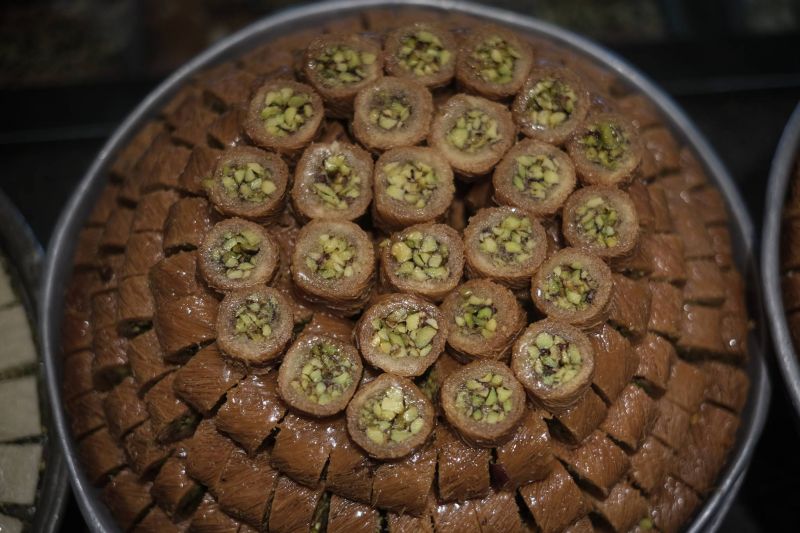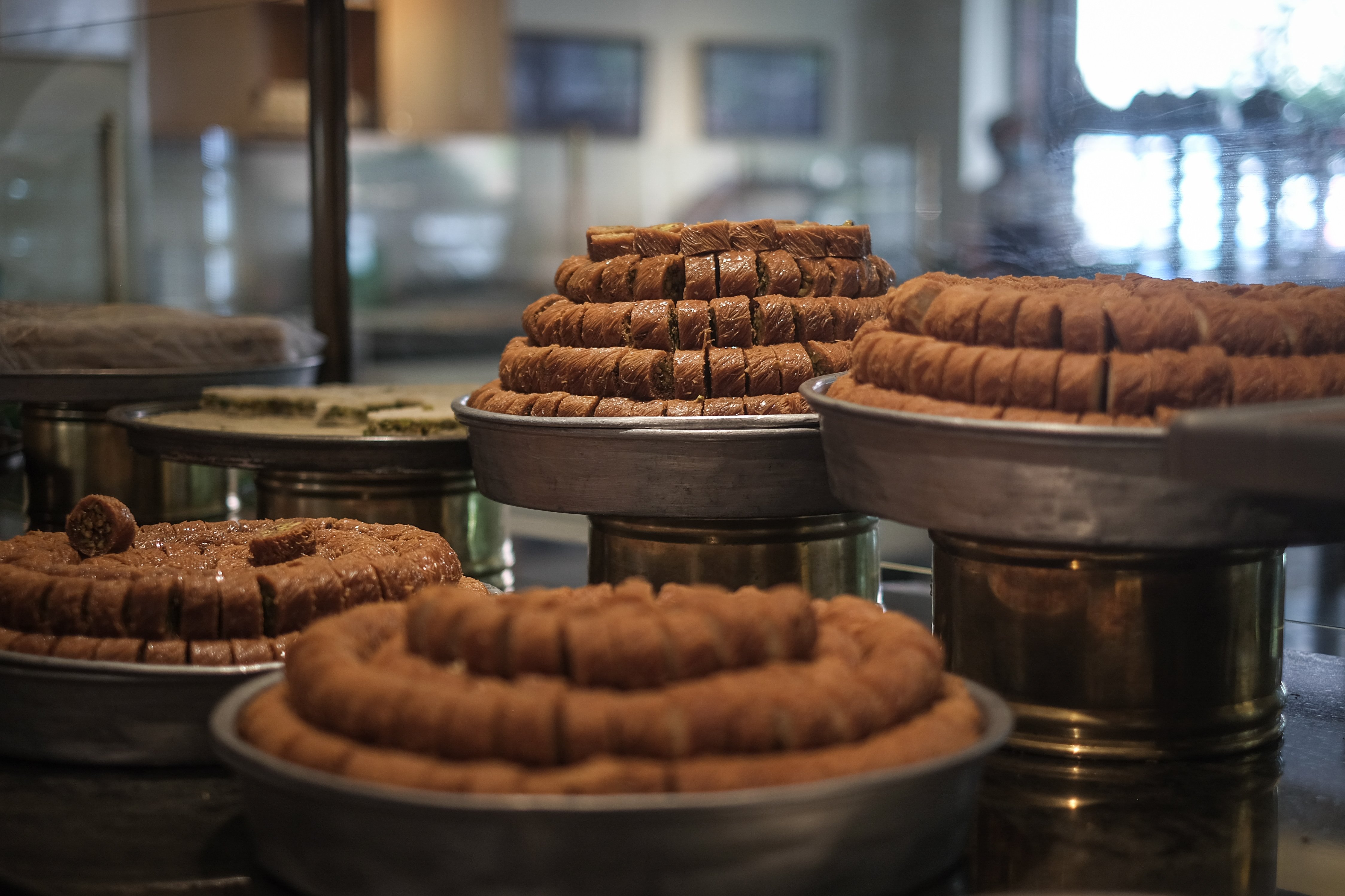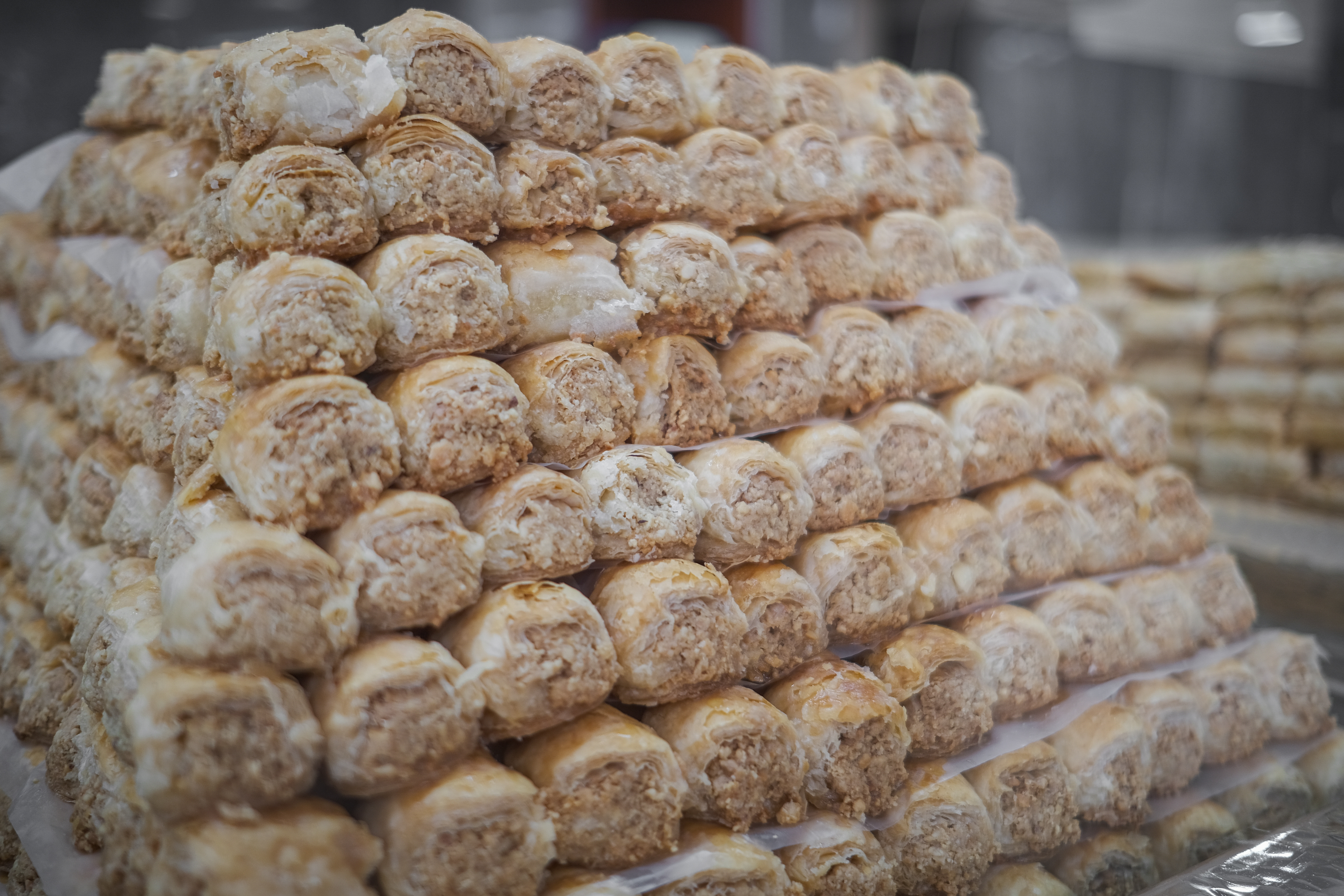
Pistachio baklawa wrapped with vermicelli. (Credit: João Sousa)
If special occasions in Lebanon had to be represented by a single dessert, that dessert would be baklawa.
Delicately layered, nut filled, and sugar drenched, the special pastry is offered almost ceremoniously on special occasions and festivities throughout the country, from marriages, baptisms and births, to Easter, Ramadan, engagements and everything in between.
Baklawa is not exactly something you find people making at home, like maamoul.
This gluttonous high calorie confection makes for a socially sanctioned and considerate gift, and is traditionally considered something to serve people you want to impress or honor.
In Lebanon, one can expect to be offered baklawa alongside a cup of strong coffee or a glass of sweet pineapple juice when paying respects, or as a final note cuing the end of a long feast.
Palace treats
It’s no wonder the treat is associated with special occasions; it was once a thing of palaces.
Historians say the oldest recorded recipe goes back to the Topkapi Palace, which housed the Ottoman Empire’s Sultans and administrative affairs since 1465. The palace was converted into a museum in 1924.
In the 1500’s, on the 15th day of Ramadan, it was tradition for the Sultan to offer his Janissaries (elite Ottoman troops) in Topkapi Palace trays of baklawa in a ceremonial procession called baklava alay (baklava procession).
“A big thing to look at when talking about sweets is that there are major class connotations. The history of food in general is very wrapped in this idea of power and class relations,” explained Tylor Brand, a Middle East history professor at Trinity College Dublin (TCD) and AUB alumni.
 Baklawa trays on display at Amal Bohsali, Koraytem. (Credit: João Sousa)
Baklawa trays on display at Amal Bohsali, Koraytem. (Credit: João Sousa)
“Things like sweets were very rare for a lot of people to get their hands on for a very long time. It was kind of expensive. To have something drenched in sugar water would have to have a palace situation,” Brand said.
“Baklava is not a common pastry. It’s a very luxurious pastry,” confirmed public historian Charles Hayek.
The baklawa enjoyed in Lebanon today differs from what was served at the Topkapi palace in the 16th century.
“[In Topkapi] It was served in big trays. It looked like kebbeh bl saniyeh [a Levantine dish typically made with bulgar and meat]. In some parts of Turkey, this way of presenting giant pieces of baklawa survived,” explained Hayek.
Origins
Hayek said historians unfortunately lack the resources needed to trace baklawa before the Ottoman period.
But he explains that “The name baklava can be traced to turkic and Mongolian languages.” It is likely derived from the Mongolian word ‘bailah’, which means “to tie” or “to wrap up.”
The origin of phyllo pastry can also be traced to Central Asia.
“It is a general rule that whenever you use layered pastry, phyllo pastry, it's a result of Turkic influence from Central Asia. It's called Yufka,” explained Hayek.
“If you want to trace something that is similar, there is something in the Abbasid period [750-1258] called lawsinaj, an almond based confection.”
Lawsinaj is among the 600 recipes found in Kitab al Tabikh, the first known Arabic cookbook written in 10th century Baghdad by Ibn Sayyar al-Warraq.
“Some historians think this can also be baklawa, but we doubt it,” said Hayek.
“In terms of the current baklava, it’s definitely Ottoman,” asserted Hayek. The treat spread by way of Ottoman influence and rule.“That’s why you find it in Greece, in the Levant, and even in the Balkans.”
 Tray of Baklava stuffed with walnuts. (Credit: João Sousa)
Tray of Baklava stuffed with walnuts. (Credit: João Sousa)
Lebanese baklawa
It wasn’t until the advent of the slave trade and the flooding of the market with sugar in the 1600’s that normal people could use sugar in everyday recipes, explained Brand.
Eventually, the recipes of the palace would spill out to the streets, and people would start imitating them, explained Hayek.
“The cities of the empire would imitate the recipes of the capital. This is how baklawa arrived to Lebanon. We don’t know exactly when and how.”
If one thing is certain, it’s that recipes quickly adapt to local ingredients.
By the late 19th century, today's leading dynasties of Lebanese pastry makers — like Bohsali, Douaihy and Hallab — started producing the pastries that were popular in Istanbul.
“The origin is not Lebanese but it became Lebanese,” added Hayek
“Every country says, ’We started it.’ Eventually I’m going to tell you we started it,” laughed Zaher Hallab, floor manager of Hallab, the popular sweets chain that has been run by his family since 1881.
“But every country prepares it in a different way. And here’s the interesting part. Go to the Lebanese sweets in Tripoli. It's crispy. It has aatter [sugar syrup] but it’s not too sweet. If you go to Beirut, it has more sugar and you can’t eat more than one or two pieces,” said Hallab.
“If you go to Syria, it's more dry. Not much sweetness, but you can really taste the nuts.Go to turkey, it's soaked in sugar syrup. They don’t care about crispiness. Each country makes it in their own way.”
Indeed, the delicacy has plenty of delicious variations across the Middle East.
“In Lebanon we are known for the little baklawas,” noted Hayek, “the fingers.”
In Greece and Armenia, baklawa is commonly made with walnuts, flavored with notes of cinnamon, and layered with exactly 33 sheets of phyllo – the years of Christ's life.
 Mountain of Baklava fingers stuffed with pine nuts. (Credit: João Sousa)
Mountain of Baklava fingers stuffed with pine nuts. (Credit: João Sousa)
In the Levant, pistachio or pine nut filling imbued with rose or orange blossom water is popular.
Around the Black Sea, one finds baklawa stuffed with earthy hazelnut, and in Iran it is infused with fragrant cardamom.
Whether it is cut into squares, diamonds, triangles, parallelograms, layered with phyllo or wrapped with vermicelli, saturated in sugary syrup or drenched in honey, baklawa remains a delicacy in its own right.
Curiously, recipes have a way of outliving their creators. The Ottoman empire is long gone, but the creations of its imperial kitchen, like today’s baklawa, are still very much alive.